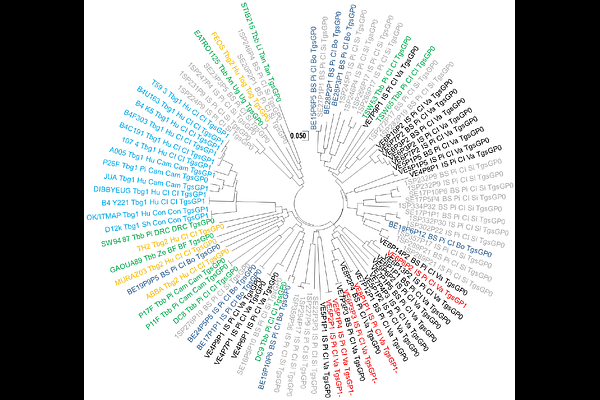Trypanosoma brucei from pigs in sleeping sickness foci from Cote Ivoire is structured into clonal and strongly subdivided populations

Trypanosoma brucei from pigs in sleeping sickness foci from Cote Ivoire is structured into clonal and strongly subdivided populations
NDJETCHI, M. K.; DE MEEUS, T.; TRAORE, B.; RAVEL, S.; SEGARD, A.; KABORE, J.; ABE, A.; KABA, D.; DJAKARIDJA, B.; KONAN, T.; COULIBALY, B.; GREBAUT, P.; BOSSARD, G.; BUCHETON, B.; KOFFI, M.; JAMONNEAU, V.
AbstractHuman African trypanosomiasis (HAT), or sleeping sickness, is currently targeted for elimination. The etiologic agent of HAT is a trypanosome belonging to the species Trypanosoma brucei (Tb) s.l., a unicellular parasite transmitted by tsetse flies. Tb s.l. consists of three subspecies: T. b. brucei (Tbb), T. b. gambiense (Tbg) and T. b. rhodesiense (Tbr). These subspecies are morphologically indistinguishable and classified according to host in which they are found, type of disease and geographical distribution. During the last few decades, there has been considerable effort to genetically characterize Tb s.l. isolated from domestic and wild animals in order to better evaluate the impact of animal reservoirs on the epidemiology of HAT. To assess genetic diversity of Tb s.l. strains circulating in three endemic or historical HAT foci in Cote Ivoire, we conducted a population genetics study of these parasites. Biological and isolated stock samples collected from pigs and reference stocks were tested with the primers of the Trypanosoma gambiense-specific-glycoprotein gene (TgsGP) and were genetically characterized with eighteen microsatellite primers. TgsGP positive samples did not fit into Tbg as regard to their microsatellite profile. We also found that in Ivoirian foci, Tbb populations (animal trypanosomes) were structured as several strongly isolated units that propagate clonally. This is in variance with other published data on that subspecies. This study confirms the need to develop better tools to explore the relationships between Tbb and Tbg and to study the epidemiological role of potential animal reservoir for Tbg.